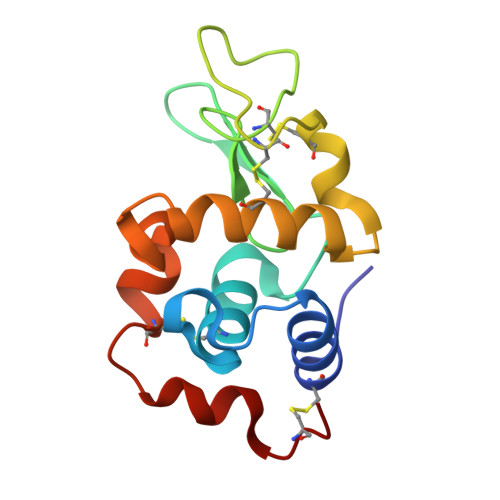Protein-Protein Stabilization in V IV O/8-Hydroxyquinoline-Lysozyme Adducts.
Paolillo, M., Ferraro, G., Pisanu, F., Marechal, J.D., Sciortino, G., Garribba, E., Merlino, A.(2024) Chemistry 30: e202401712-e202401712
- PubMed: 38923243
- DOI: https://doi.org/10.1002/chem.202401712
- Primary Citation of Related Structures:
8RTJ, 8RTK - PubMed Abstract:
The binding of the potential drug [V IV O(8-HQ) 2 ], where 8-HQ is 8-hydroxyquinolinato, with hen egg white lysozyme (HEWL) was evaluated through spectroscopic (electron paramagnetic resonance, EPR, and UV-visible), spectrometric (electrospray ionization-mass spectrometry, ESI-MS), crystallographic (X-ray diffraction, XRD), and computational (DFT and docking) studies. ESI-MS indicates the interaction of [V IV O(8-HQ)(H 2 O)] + and [V IV O(8-HQ) 2 (H 2 O)] species with HEWL. Room temperature EPR spectra suggest both covalent and non-covalent binding of the two different V-containing fragments. XRD analyses confirm these findings, showing that [V IV O(8-HQ)(H 2 O)] + interacts covalently with the solvent exposed Asp119, while cis-[V IV O(8-HQ) 2 (H 2 O)] non-covalently with Arg128 and Lys96 from a symmetry mate. The covalent binding of [V IV O(8-HQ)(H 2 O)] + to Asp119 is favored by a π-π contact with Trp62 and a H-bond with Asn103 of a symmetry-related molecule. Additionally, the covalent binding of V V O 2 + to Asp48 and non-covalent binding of other V-containing fragments to Arg5, Cys6, and Glu7 are revealed. Molecular docking indicates that, in the absence of the interactions occurring at the protein-protein interface close to Asp119, the covalent binding to Glu35 or Asp52 should be preferred. Such a protein-protein stabilization could be more common than what believed up today, at least in the solid state, and should be considered in the characterization of metal-protein adducts.
- Department of Chemical Sciences, University of Naples 'Federico II', Complesso Universitario di Monte Sant'Angelo, Via Cintia, I-80126, Napoli, Italy.
Organizational Affiliation:




















